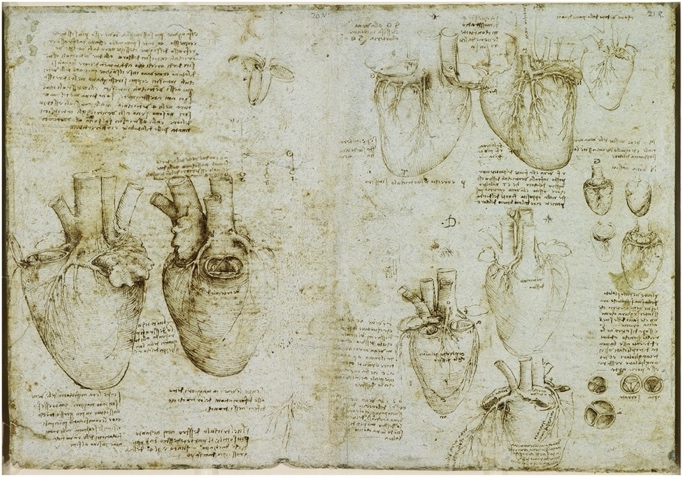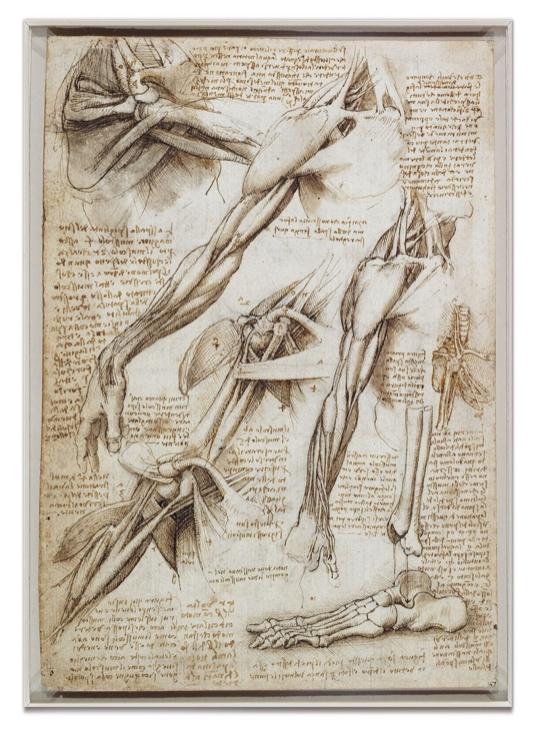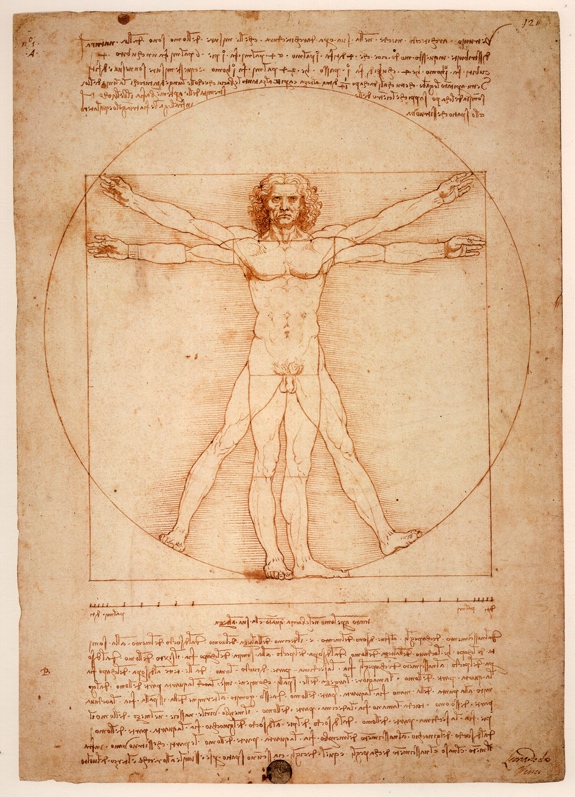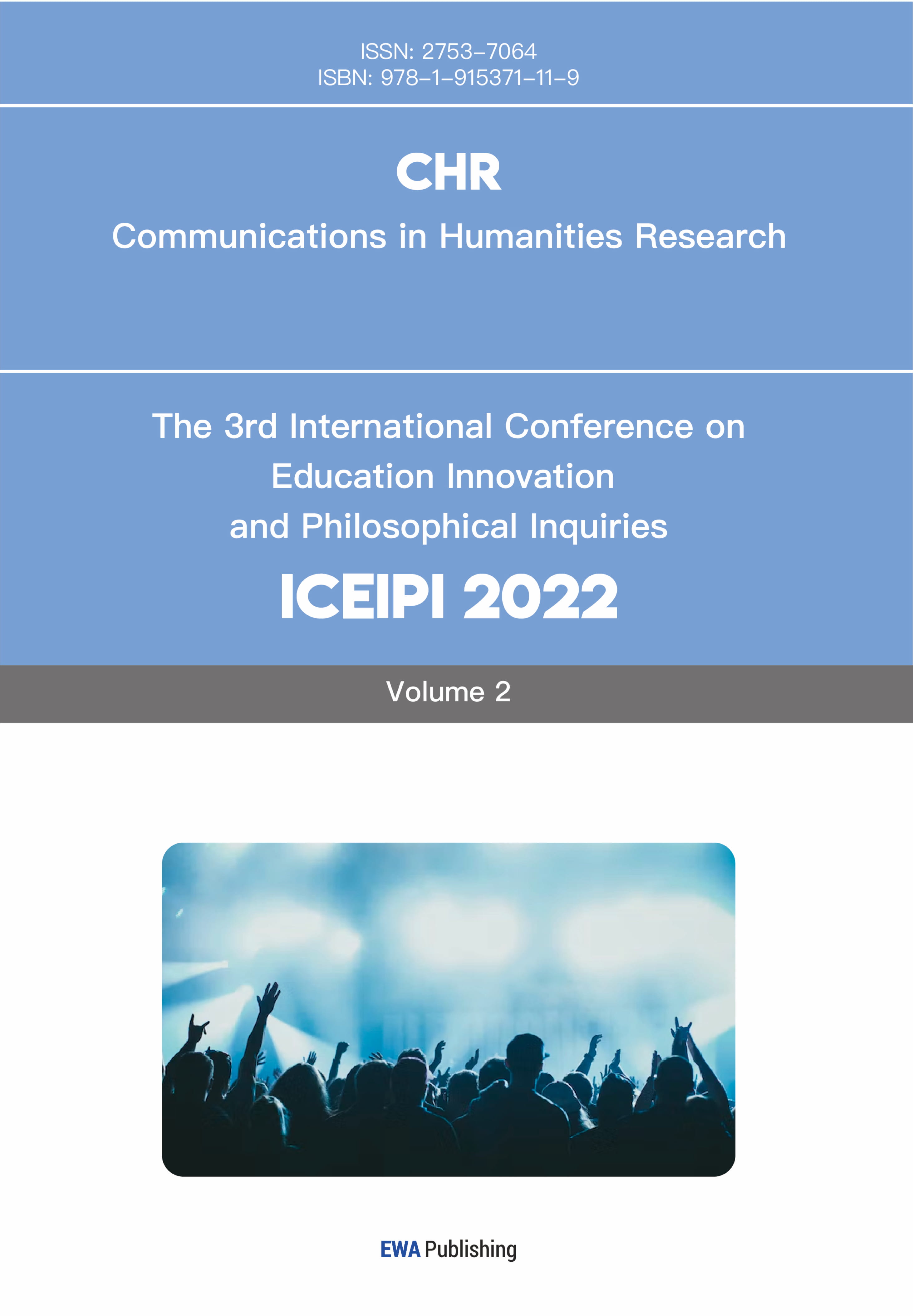1. Introduction
In the light of the Renaissance, science was introduced to a broader range of audiences, and people began searching for more realistic portrayals of reality. Wanting to bring back the golden age, the church brought science back into their daily lives, causing more people to emerge themselves into the world of art and science. Artists and scientists from the Renaissance sought to develop humanism and other shared values through disciplines like painting, anatomy, and geometry. They strive for a deeper understanding of the cosmos. Leonardo da Vinci, commonly known as an exceptional painter and inventor, was one of the masterminds who emerged from the Renaissance. He made revolutionary connections between art and anatomy during the Renaissance. In the sixteenth century, Leonardo stayed in Florence studying anatomy, during which he created many clinically accurate atomical drawings. At the same time, he used his knowledge of anatomy to advance his drawings into more natural forms. By observing the inner structures of the human body, Leonardo gained knowledge of creating more accurate human proportions and realistic body shapes. His artistic surge for anatomical knowledge revolutionized traditional anatomy and made his artistic observations more realistic.
Leonardo da Vinci brought Renaissance anatomy into the light during the sixteenth century by combining anatomy with drawings. During his stay in Florence around 1500, Leonardo immersed himself in studying anatomy and expressing his new scientific knowledge by making clinically accurate atomical drawings. On the one hand, he used his exceptional artistic skills, including the use of perspective and his naturalistic portrayal of reality, to take physiology and schematics to the next level. His artistic surge for anatomical knowledge helped him revolutionize traditional anatomy. On the other hand, Leonardo da Vinci used his scientific knowledge of anatomy and geometry to transform his artworks into a more naturalistic portrayal of reality with details of the structure and proportion of the human body. Through studying the inner and outer structure of the human body, ranging from bones to muscles, Leonardo combined artistic and scientific objectives together, creating a realistic reflection of the human body. By taking on concepts from previous Renaissance masters and studying the usage and appearance of different muscles while moving the body, Leonardo enhanced his artworks by being more naturalistic and turning himself into a genius artist-anatomist.
Leonardo challenged the traditional way of learning anatomy, which includes rarely watching dissections and learning from inaccurate schematics. He used his painting skills and revolutionary ideas of merging science and art into an apprehensible combination to bring Renaissance anatomy into the light. His Study of a Heart utilizes techniques like chiaroscuro and perspective to create an easily understandable piece for others to use. Leonardo stimulated the fusion of art and science in anatomical representation through his understanding of anatomy and painting. Moreover, following the artistic trend set by Leon Battista Alberti of learning about both inner organs and outer structures of the body, Leonardo made realistic portrayals in his artworks. From his muscles of the shoulder and arm and the bones of the foot and The Vitruvian Man, Leonardo combined his scientific knowledge to create realistic effects in his pieces. He combined artistic and scientific objectives to enhance his drawings, making them more accurate and naturalistic.
2. Leonardo’s influence on Anatomy
Leonardo da Vinci, famously known as the mastermind painter and inventor, brought Renaissance anatomy into the light during the sixteenth century by combining anatomy with drawings. During his stay in Florence around 1500, Leonardo emerged himself into studying anatomy with a professional anatomist, Marcantonio Della Torre. During this time, he studied the human body carefully and learned about the circulation of blood, along with other biological discoveries. Leonardo made clinically accurate atomical drawings expressing his ideas and discoveries by expressing his new scientific knowledge. He used his exceptional artistic skills, including the use of perspective and his naturalistic portrayal of reality, to take physiology and schematics to the next level. His artistic surge for anatomical knowledge helped him become an artist-anatomist and revolutionized traditional anatomy [1].
Anatomy before Leonardo was schematic based on theory instead of observation. Because people were only allowed to dissect criminals, the majority of dissections were conducted by trained surgeons, not artists. The only way for people to study anatomy was to attend anatomical demonstrations where dissections were performed in theatres. Medical students surrounded the table where the dissection occurred to get a glimpse of the process. They could only learn through watching, not through realistic diagrams. The schematics physicians used were also unnaturalistic and difficult to understand. They were drawn with no perspective, meaning there were no dimensions in the diagrams, and everything looked flat. Another problem was that the drawings were commonly drawn not to scale and proportion, easily misleading medical students. The misrepresentation of human anatomy and little exposure to real corpses and dissections made it difficult for physicians before Leonardo to learn about the human body.
On the contrary, Leonardo revolutionized the old learning method by merging science and art into an apprehensible combination. Using his skills in art, Leonardo incorporated new Renaissance painting techniques like the use of perspective and chiaroscuro in his anatomical studies. He developed new ways of presenting anatomical images, including “exploded diagrams,” micro-details, high naturalism, and annotations, which had never been seen before in scientific drawings. After doing anatomical work with Marcantonio Della Torre, Leonardo “made a book drawn with red chalk and annotated with a pen.” Later in his life, this book was shown to the Cardinal Luis of Aragon, to which he responded, “This gentleman has written of anatomy with such details … in a way that has never yet been done by anyone else”. Similarly, most people who saw the work commented mainly on the accuracy and artistic value, not the science of anatomy. Leonardo’s work was realistic and easy to understand compared to the traditional schematic before him. His drawings are almost the same as the real objects. It created a new path for medical students, or even commoners, to learn about human anatomy. The connections he made between science and art also inspired younger generations of European artists, like Albrecht Dürer, to study science. Records revealed that Dürer’s studies on human proportion were likely to be influenced by Leonardo [2].

Figure 1: Study of a Heart c.1511-13 Pen and ink on blue paper 28.8 x 41.3 cm, Thereza Wells, ed. (2008). Notebooks of Leonardo da VInci, selected by Irma A. Richter. Oxford World's Classics (new ed.). Oxford: Oxford University Press.
In his sketches, Leonardo used his knowledge of science and art to revolutionize traditional anatomy. Study of a Heart is one of his studies that includes a large depiction of an anatomical object and annotations surrounding the sketch to explain its mechanism and function. Combined with the annotations, this study was the first to point out that the heart is four-chambered and is composed of muscles [3]. On the left side of the page, depictions of a heart, possibly an Ox’s heart, are shown in extreme detail, including its auricular appendages and aorta. There are two images shown from different views, one from the side and the other from the front of the organ. The heart is drawn with an irregular shape that gives the feeling of a soft and flexible material. The top of the heart is cut open, revealing the valves and arteries attached to the rest of the body. The arteries look like they are bent into the position they are in to connect with the surrounding, which indicates the realism of the study. The right ventricle surrounding the center of the heart is also drawn elaborately, with thin strokes extending down to the bottom of the heart. Additionally, Leonardo used chiaroscuro to create the light and shadow of a real heart. He used a darker color on the side and back of the heart, where shadows must have been, to create a naturalistic representation of it. The interior of the heart chambers and areas between the ventricles on the top is also shaded with fine lines to create dimension. Overall, the heart is drawn realistically and delicately. It is easy for people, even those without a scientific background, to understand the structure of the heart. Thus, Leonardo joined science and art to create a sophisticated combination that helped people to understand science more thoroughly.
However, this study is not considered a perfect human heart diagram despite its realistic portrayal of the organ. With the knowledge of modern anatomy, it is likely to be the heart of an ox because it deviates from the structure of a human heart. The sketch shows the two venae cavae, superior and inferior, merged before reaching the atrium, making the study impossible to be the heart of a human [4]. Because "anatomy was an illicit and sacrilegious activity" during the sixteenth century, Leonardo probably had little exposure to human corpses. The solution he found was that instead of using solely human anatomy, he combined his sophisticated observations of animal anatomy with the “received wisdom” from books [5]. This means that his drawings could still be realistic while not offending the Church. As a result, many of his studies, like the Study of a Heart, comprised elements both from humans and animals since animal material is only different in shape and dimension. Therefore, the images shown in some of his studies might not be completely clinically accurate. Even though the anatomical drawing of the heart can be misleading, it is still considered superior compared to the majority of anatomical drawings in the same period.
Responding to traditional anatomy’s common misrepresentation of human anatomy and the minimal exposure people had to real corpses, Leonardo created a path for science and brought anatomy out of the dark. Leonardo da Vinci stimulated the fusion of art and science in anatomical representation through his understanding of anatomy and painting. He used his skills as an artist, including the use of perspective and chiaroscuro, to create naturalistic depictions of anatomical subjects. This resulted in helping more people to understand human anatomy and boosting the development of the field.
3. Leonardo’s influence on Art
Furthermore, Leonardo da Vinci used his understanding of science, including anatomy and geometric proportions, to help him create more detailed and accurate drawings. By taking on concepts from previous Renaissance masters and popular ideas at the time, Leonardo formulated his guidelines for depicting a realistic portrayal. He studied the usage and appearance of different muscles while moving the body and also ideal body proportions from Vitruvius. Using science, Leonardo enhanced his artworks by being more naturalistic and turning himself into a genius artist-anatomist.
To properly depict characters in his drawings, Leonardo studied the insides of the body. Renaissance theorist Leon Battista Alberti said that artists should “isolate each bone of the animal, on this add its muscles, then clothe all of it with its flesh.” In his treatise On Painting in 1435, he wrote, “before dressing a man we first draw him nude, then we enfold him in draperies. So in painting the nude, we place first his bones and muscles, which we then cover with flesh so that it is not difficult to understand where each muscle is beneath.” [6] Alberti advised painters to design their human figures with the help of their skeleton and muscles. After this, they should add on the clothes and skin. Alberti’s theories about the connection between painting and anatomy brought a wave of artists learning anatomy in order to improve their depictions of the human body, and Leonardo was one of them. During his studies of anatomy in Rome, Leonardo da Vinci observed and learned about both the outside and the inside of the human body. He observed the static structure of the body and also studied the structures of internal organs, like the brain, lungs, and heart. His anatomical observations of the human body enabled him to portray realistic reflections in his artworks.

Figure 2: The muscles of the shoulder and arm and the bones of the foot c.1510–11 Pen and ink over traces of black chalk 39.0 × 26.5 cm, Thereza Wells, ed. (2008). Notebooks of Leonardo da VInci, selected by Irma A. Richter. Oxford World's Classics (new ed.). Oxford: Oxford University Press.
For instance, Leonardo’s studies of The Muscles of the Shoulder and Arm and the Bones of the Foot used anatomy to show the dissection of the body structures. In the drawing, different segments of the body are shown in great detail. The bones serve as the center of the study, surrounded by skin and muscle. Leonardo studied the structure of each bone and used them in his work. In the right bottom corner, the bone structure of a foot and a leg bone connecting the foot is drawn realistically. Leonardo even labeled the way and direction the joint is supposed to conjoin the two pieces. On the top of the page, studies of the shoulder and arm reveal that Leonardo studied how the muscles contracted in different positions. When the arm is held forward vertically, the muscle of the back of the body is used. Similarly, when the arm is held horizontally, the deltoid muscle is contracted. With all the different muscles on the arm and shoulder shown naturalistically, the overall depiction of the human is relatively accurate, achieving one possible goal of the artist.
Leonardo’s involvement in anatomy ranged from dissecting bodies to studying the inner organs. With all the knowledge he gained in anatomy, Leonardo advanced in his painting techniques and accurate portrayal of the human body in his masterpieces. Through studying physical anatomy, Leonardo understood the structure of the inner bones and muscles. This way, he would know which muscle is likely to appear stretched while the arm is positioned in a certain way. His studies helped him to understand the human body better and therefore create better and more realistic drawings.

Figure 3: Study Of The Proportions Of The Human Body, Known As The Vitruvian Man c. 1490 34.4 cm × 24.5 cm Metalpoint, pen, and ink, touches of watercolor on white paper, Thereza Wells, ed. (2008). Notebooks of Leonardo da VInci, selected by Irma A. Richter. Oxford World's Classics (new ed.). Oxford: Oxford University Press.
Alongside anatomy, Leonardo also utilized geometry to help him further improve his depictions of the human body. His famously known folio of the Vitruvian Man is an example of where synergy exists between art and science. Drawn with ink on paper, the Vitruvian Man depicts a nude male figure standing with his arms and legs apart while circumscribed by a circle and a square. The man is shown in two different positions, one standing straight while the other separates the legs further to the side. Drawn on a coronal plane, the Vitruvian Man was used to show the geometrical dimensions of the human body. The sketch was created with annotations that suggest that the work is based on the description by the famed Roman architect Marcus Vitruvius Pollio [7]. In his book De Architectura, Vitruvius wrote, “The navel is in the center of the human body, and, if in a man lying with his face upward, and his hands and feet extended, from his navel as the center, a circle be described, it will touch his fingers and toes. It is not alone by a circle that the human body is thus circumscribed, as may be seen by placing it within a square” [8]. He provided ideas such as changing the center of magnitude without differentiating the center of normal gravity. Leonardo incorporated Vitruvius’ ideas into his studies and the human body. From his notes on the side, Leonardo said, “the measurements of man are in nature distributed in this manner, that is four fingers make a palm, four palms make a foot, six palms make a cubit, four cubits make a man, four cubits make a footstep, 24 palms make a man, and these measures are in his buildings” [9]. Leonardo da Vinci's anatomical paintings are not only the beginning of naturalism but also a high expression of artistic creation techniques. Among the mainstream studies of Renaissance painting techniques, the most well-known is Hall's study of the four painting techniques, of which Leonardo da Vinci is particularly known for the creation of the sfumato technique [10]. We will note that just as extra attention was paid to the texture and the subtle layers that make up things in deconstruction and the natural understanding of the world, this basic spirit or method of observing things is once again present in his sfumato technique. This is not an accident of individual experience but implies the real existence of a highly consistent and effective combination of scientific spirit and art in the Renaissance.
4. Conclusion
Leonardo challenged the traditional way of learning anatomy, which includes rarely watching dissections and knowledge-seeking observations from inaccurate schematics. He used his painting skills and revolutionary ideas of merging science and art into an apprehensible combination to bring Renaissance anatomy into the light. In general, Leonardo combined artistic and scientific objectives together, creating a realistic reflection of the human body. He uses geometric proportions of the body and anatomical portray to enhance his drawings making them more naturalistic. For centuries, scholars have attributed the invention of natural vision in western painting to scientific methods. This belief is still dominating the understanding of naturalism today. By the rediscovery of how Leonardo combined artistic and scientific objectives together, an anti-dualism way to understand the scientific innovation and development of art is within reach.
References
[1]. Keele, D. (2012) Leonardo Da Vinci’s Influence on Renaissance Anatomy. Cambridge University Press, 360-69.
[2]. Thereza Wells, ed. (2008). Notebooks of Leonardo da VInci, selected by Irma A. Richter. Oxford World's Classics (new ed.). Oxford: Oxford University Press.
[3]. Jose, A.M . (2001) Anatomy and Leonardo da Vinci. Yale Journal of Biology And Medicine 74, 194-5.
[4]. Clayton, M., Ronald P. (2012) Leonardo Da Vinci, Anatomist. London: Royal Collection Publications, 226-7.
[5]. Kemp, M. (2004) Leonardo. Oxford: Oxford University Press, 93-7.
[6]. Alberti, B, Rocco S. (2013) Leon Battista Alberti: On Painting: A New Translation and Critical Edition. Cambridge: Cambridge University Press.
[7]. Ashrafian, H. (2011) Leonardo da Vinci’s Vitruvian Man: a renaissance for inguinal hernias. Hernia; Paris Vol. 15, Iss. 5.
[8]. Vitruvius. (2014) The Ten Books on Architecture. Translated by Morris Hicky Morgan, Harvard University Press.
[9]. Magazù, S., Coletta, N., Migliardo, F. (2019) The Vitruvian Man of Leonardo da Vinci as a Representation of an Operational Approach to Knowledge. Foundations of Science.
[10]. Hall, M. B. (1994). The scientific renaissance 1450-1630. Courier Corporation.
Cite this article
Dong,J. (2023). Leonardo’s Influence on Anatomy and Art during the Renaissance. Communications in Humanities Research,3,358-364.
Data availability
The datasets used and/or analyzed during the current study will be available from the authors upon reasonable request.
Disclaimer/Publisher's Note
The statements, opinions and data contained in all publications are solely those of the individual author(s) and contributor(s) and not of EWA Publishing and/or the editor(s). EWA Publishing and/or the editor(s) disclaim responsibility for any injury to people or property resulting from any ideas, methods, instructions or products referred to in the content.
About volume
Volume title: Proceedings of the International Conference on Interdisciplinary Humanities and Communication Studies (ICIHCS 2022), Part 1
© 2024 by the author(s). Licensee EWA Publishing, Oxford, UK. This article is an open access article distributed under the terms and
conditions of the Creative Commons Attribution (CC BY) license. Authors who
publish this series agree to the following terms:
1. Authors retain copyright and grant the series right of first publication with the work simultaneously licensed under a Creative Commons
Attribution License that allows others to share the work with an acknowledgment of the work's authorship and initial publication in this
series.
2. Authors are able to enter into separate, additional contractual arrangements for the non-exclusive distribution of the series's published
version of the work (e.g., post it to an institutional repository or publish it in a book), with an acknowledgment of its initial
publication in this series.
3. Authors are permitted and encouraged to post their work online (e.g., in institutional repositories or on their website) prior to and
during the submission process, as it can lead to productive exchanges, as well as earlier and greater citation of published work (See
Open access policy for details).
References
[1]. Keele, D. (2012) Leonardo Da Vinci’s Influence on Renaissance Anatomy. Cambridge University Press, 360-69.
[2]. Thereza Wells, ed. (2008). Notebooks of Leonardo da VInci, selected by Irma A. Richter. Oxford World's Classics (new ed.). Oxford: Oxford University Press.
[3]. Jose, A.M . (2001) Anatomy and Leonardo da Vinci. Yale Journal of Biology And Medicine 74, 194-5.
[4]. Clayton, M., Ronald P. (2012) Leonardo Da Vinci, Anatomist. London: Royal Collection Publications, 226-7.
[5]. Kemp, M. (2004) Leonardo. Oxford: Oxford University Press, 93-7.
[6]. Alberti, B, Rocco S. (2013) Leon Battista Alberti: On Painting: A New Translation and Critical Edition. Cambridge: Cambridge University Press.
[7]. Ashrafian, H. (2011) Leonardo da Vinci’s Vitruvian Man: a renaissance for inguinal hernias. Hernia; Paris Vol. 15, Iss. 5.
[8]. Vitruvius. (2014) The Ten Books on Architecture. Translated by Morris Hicky Morgan, Harvard University Press.
[9]. Magazù, S., Coletta, N., Migliardo, F. (2019) The Vitruvian Man of Leonardo da Vinci as a Representation of an Operational Approach to Knowledge. Foundations of Science.
[10]. Hall, M. B. (1994). The scientific renaissance 1450-1630. Courier Corporation.









